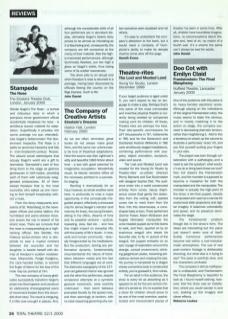One of the problems with this piece is its heavy-handed electronic score. Although playing on the melodrama of the original Frankenstein story, the music seems to state the obvious, and in merely matching it to the action on stage, the company succeed in decreasing dramatic tension, rather than heightening it. Add to this a tendency to whack up the volume to illustrate a particularly 'scary’ bit, and you find yourself putting your fingers in your ears.
The project was born through collaboration with a pathologist, and a need to ask the question: what wouldn't we do to bring back those we love? Doo-Cot dissect the Frankenstein myth, and the monster is supposed to become a metaphor for both the manipulated and the manipulator. The monster is actually the high-point of the show: a ten-foot puppet, cleverly manipulated and used as a canvas for anatomical slide-projections and digital imagery. It balances vulnerability and power, and its presence dominates the stage.
The fundamental problem though lies in the show's form. The ideas are interesting but the piece just doesn't seem sure of itself. Subtly humorous performances become lost within a cod-melodramatic atmosphere. The use of real postmortem footage is deliberately shocking, but what else is it trying to say? The pace is painfully slow, and the characters confused.
The company's skill as craftspeople is undisputed, and Frankenstein: The Final Blasphemy is beautiful to look at. I found myself wishing, however, that the show was an installation where you could wander in and out, soaking up the imagery and clever effects.

